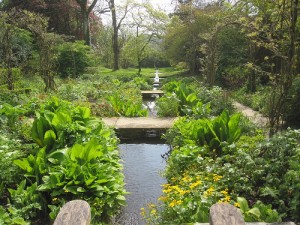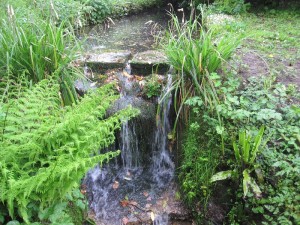“Water is the eye of the landscape” this is what my lecturer Peter Thoday used to tell us. Reservoirs, lakes, rivers, the sea and even our small garden ponds; they never fail to demand our attention, their magical surfaces reflecting the moods of the weather and the shifting shadows of the surrounding landscape. Up close we are drawn to peer into the depths or maybe indulge in a bit of wild swimming.
This medium, the source of life on our blue planet, can be manipulated endlessly to create sound, habitat, irrigation, etc… and the garden at Shute House ( Donhead St Mary, near Shaftesbury) illustrates this rather well.
It was at Shute House that I found myself on a winding path through a lush grove of Camelia and Prunus laurocerassus which opened onto a deep circular pool, squeezing me and the path up against the overhanging greenery. The crystal water was deep with hints of turquoise as it disappeared from view.
In the 1960’s, garden designer, Geoffrey Jellicoe used the water from this spring fed pool, weaving it around the modest sized garden in the form of pools, canals, musical waterfalls and rills before releasing it out of the garden through two more pools in the water meadow below and eventually into the river Nadder at the bottom of the valley. An ingenious use of a natural water source in a hillside garden and described by many as Jellicoe’s ‘masterpiece’.
Be inspired! Water in the garden does not have to rely on a natural spring or stream, nor on a pumped system from the mains tap. It falls freely from the sky, can be captured and used in our gardens creatively. Nigel Dunnett, of Sheffield University, designs with rainwater to create “rain gardens”, magical! http://www.nigeldunnett.info/Raingardens/

